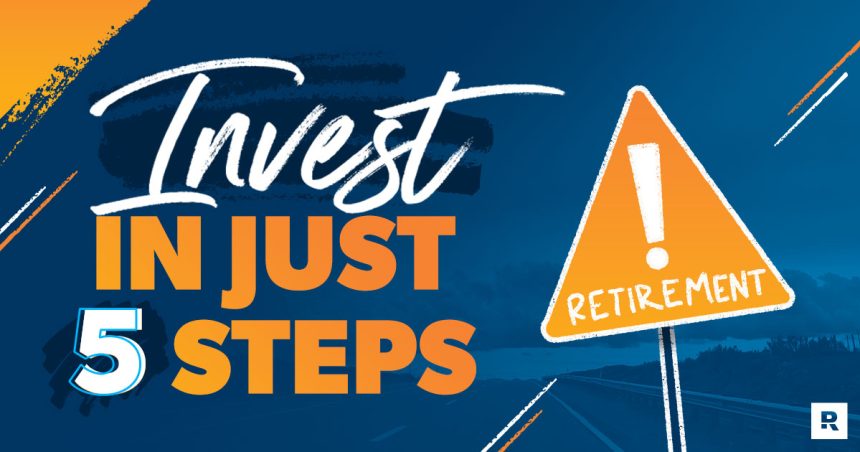You worked really hard to get yourself out of debt. You kept up that intensity and built a solid emergency fund to protect yourself and your family when life happens. Now, you’re finally ready to really start moving the ball down the field by investing for your future.
Let us be the first to say, “Way to go!” That’s a very exciting place to be. But trying to figure out how to invest your money can feel a little intimidating. It’s easy to go from pumped at the idea of saving for retirement to panicked trying to decide what to invest in. These are some big decisions. We get it.
The truth is, learning how to invest doesn’t have to be complicated. In fact, you can start saving for your future right now in a few simple steps:
We’re going to walk you through how to get started with investing so you can start working toward your retirement dreams.
Ready? Let’s do this!
Step 1: Set goals for your investments.
This is important. Take a step back for a second. What does your dream retirement look like? Have you ever really thought about it?
No matter what age or stage of life you’re in, it’s never too early or too late to think about what you want to do in retirement someday. And make no mistake, someday is coming—and what it looks like depends on what you do today.
It’s not enough to invest just for the sake of investing. You need to have a strong why, something that keeps you going when times get tough and you’re tempted to jump ship.
So, to get started, set up a dream meeting with your spouse (or if you’re single, meet up with a trusted friend or family member), and talk about some of the things you want to do in your golden years. You might be surprised what you both come up with!
But it’s not enough to dream. You need a plan to turn those ideas into reality. You need to know exactly how much you’ll need to fund your retirement dream. We have a free online tool that will help you set a goal you can start working toward today.
You can do this!
Step 2: Save 15% of your income for retirement.
Now, it’s time to put your hard-earned dollars to work. When you’re out of debt and have an emergency fund with three to six months of expenses saved, start investing 15% of your gross income toward retirement.
Why 15%? Because there are some other goals you need to set money aside for—like paying off your home early or saving for your kids’ college fund. Just remember, when it comes to juggling college savings and your own retirement goals, saving 15% of your income for retirement comes first.
The next step is to decide where to invest your money. Here’s a simple rule of thumb to keep in mind—match beats Roth beats traditional. Here’s how that might play out:
- If you have a match through your workplace retirement plan, start with your 401(k) and invest enough to at least receive that full employer match.
- After that, you (and your spouse, if you’re married) can open a Roth IRA and max out your contributions there.
- If you still haven’t hit 15% after you max out your Roth IRA, just go back to your 401(k) and bump up your contributions until you do.
This is the tried-and-true process that thousands of Baby Steps Millionaires followed to build their seven-figure net worth—and it will work for you too!
Step 3: Choose good growth stock mutual funds.
It’s normal to feel overwhelmed by all the mutual fund options when you’re making your 401(k) selections or talking through your Roth IRA options with a financial advisor. With so many choices, it can be hard to figure out the best way to invest your money.
Market chaos, inflation, your future—work with a pro to navigate this stuff.
But choosing the right mutual funds is really simple if you have a strategy. We recommend keeping your portfolio diversified by spreading your investments evenly across four mutual fund categories:
- Growth
- Growth and income
- Aggressive growth
- International
Yes, it’s that simple! Keeping your portfolio balanced with these four types of funds can help you minimize your risk and still take advantage of the returns the stock market can offer.
If you’re confused about your fund options, talk to a financial advisor or investment professional. They can help you make sense of the details so you can feel confident about how you’re investing your money.
Step 4: Invest with a long-term perspective.
When the market spikes or dips, it’s easy to make emotional decisions about your investments. Just remember: Saving for retirement is a marathon—not a sprint. And the sooner you start investing, the bigger advantage you’ll have from time and compound growth working together.
Here’s what we mean: Let’s say you start investing $800 a month in good growth stock mutual funds when you’re 35. If your investment grows for 30 years at the historic average annual rate of return (which is between 10-12%), you could have over $2.2 million when you retire. How much of that is money you put in? Less than $300,000. The rest is compound growth! If you want to dive in deeper, check out our investment calculator and plug in your own numbers.
According to The National Study of Millionaires, financial discipline and consistent investing are the keys millionaires use to build wealth. That means they put money into their 401(k)s and IRAs like clockwork for decades—no matter what was happening on Wall Street. You see, millionaires focus on what they can control, not on what’s out of their control.
And one last thing: Do not cash out your 401(k). Don’t steal from your future to fund your new kitchen remodel or dream vacation. Keep your hands off your retirement accounts until you’re ready to retire, and invest consistently year after year—regardless of what the market is doing. That’s a long-term investing strategy you can count on.
Step 5: Get help from an investing professional.
Listen, you don’t need to have all the answers about long-term retirement investing. But you do want to have someone in your corner who can help you along in your financial journey.
That’s why we recommend working with an experienced investment pro who can answer your questions and show you how to get your retirement savings started the right way.
Find a financial advisor who’ll stick with you for the long haul and help you stay on track even when times are tough. If you don’t have an advisor, we can put you in touch with an experienced investing pro in your area.
Find a SmartVestor Pro today!
This article provides general guidelines about investing topics. Your situation may be unique. If you have questions, connect with a SmartVestor Pro. Ramsey Solutions is a paid, non-client promoter of participating Pros.
Read the full article here
















